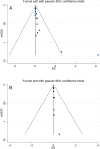The Impact of SARS-CoV-2 on Stroke Epidemiology and Care: A Meta-Analysis
- PMID: 33219563
- PMCID: PMC7753413
- DOI: 10.1002/ana.25967
The Impact of SARS-CoV-2 on Stroke Epidemiology and Care: A Meta-Analysis
Abstract
Objective: Emerging data indicate an increased risk of cerebrovascular events with severe acute respiratory syndrome coronavirus 2 (SARS-CoV-2) and highlight the potential impact of coronavirus disease (COVID-19) on the management and outcomes of acute stroke. We conducted a systematic review and meta-analysis to evaluate the aforementioned considerations.
Methods: We performed a meta-analysis of observational cohort studies reporting on the occurrence and/or outcomes of patients with cerebrovascular events in association with their SARS-CoV-2 infection status. We used a random-effects model. Summary estimates were reported as odds ratios (ORs) and corresponding 95% confidence intervals (CIs).
Results: We identified 18 cohort studies including 67,845 patients. Among patients with SARS-CoV-2, 1.3% (95% CI = 0.9-1.6%, I2 = 87%) were hospitalized for cerebrovascular events, 1.1% (95% CI = 0.8-1.3%, I2 = 85%) for ischemic stroke, and 0.2% (95% CI = 0.1-0.3%, I2 = 64%) for hemorrhagic stroke. Compared to noninfected contemporary or historical controls, patients with SARS-CoV-2 infection had increased odds of ischemic stroke (OR = 3.58, 95% CI = 1.43-8.92, I2 = 43%) and cryptogenic stroke (OR = 3.98, 95% CI = 1.62-9.77, I2 = 0%). Diabetes mellitus was found to be more prevalent among SARS-CoV-2 stroke patients compared to noninfected historical controls (OR = 1.39, 95% CI = 1.00-1.94, I2 = 0%). SARS-CoV-2 infection status was not associated with the likelihood of receiving intravenous thrombolysis (OR = 1.42, 95% CI = 0.65-3.10, I2 = 0%) or endovascular thrombectomy (OR = 0.78, 95% CI = 0.35-1.74, I2 = 0%) among hospitalized ischemic stroke patients during the COVID-19 pandemic. Odds of in-hospital mortality were higher among SARS-CoV-2 stroke patients compared to noninfected contemporary or historical stroke patients (OR = 5.60, 95% CI = 3.19-9.80, I2 = 45%).
Interpretation: SARS-CoV-2 appears to be associated with an increased risk of ischemic stroke, and potentially cryptogenic stroke in particular. It may also be related to an increased mortality risk. ANN NEUROL 2021;89:380-388.
© 2020 American Neurological Association.
Conflict of interest statement
Nothing to report.
Figures





References
-
- World Health Organization . Corona‐virus disease (COVID‐19) outbreak. Available at: https://www.who.int/emergencies/diseases/novel-coronavirus-2019/. Accessed May 5, 2020.
Publication types
MeSH terms
LinkOut - more resources
Full Text Sources
Medical
Miscellaneous

